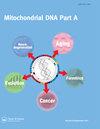Analysis of mitochondrial genetic diversity of Ustilago maydis in Mexico
IF 0.6
4区 生物学
Q4 GENETICS & HEREDITY
引用次数: 13
Abstract
Abstract The current understanding of the genetic diversity of the phytopathogenic fungus Ustilago maydis is limited. To determine the genetic diversity and structure of U. maydis, 48 fungal isolates were analyzed using mitochondrial simple sequence repeats (SSRs). Tumours (corn smut or ‘huitlacoche’) were collected from different Mexican states with diverse environmental conditions. Using bioinformatic tools, five microsatellites were identified within intergenic regions of the U. maydis mitochondrial genome. SSRMUM4 was the most polymorphic marker. The most common repeats were hexanucleotides. A total of 12 allelic variants were identified, with a mean of 2.4 alleles per locus. An estimate of the genetic diversity using analysis of molecular variance (AMOVA) revealed that the highest variance component is within states (84%), with moderate genetic differentiation between states (16%) (FST = 0.158). A dendrogram generated using the unweighted paired-grouping method with arithmetic averages (UPGMA) and the Bayesian analysis of population structure grouped the U. maydis isolates into two subgroups (K = 2) based on their shared SSRs.墨西哥黑穗病菌线粒体遗传多样性分析
摘要目前对植物致病真菌麦氏黑穗病菌(Ustilago maydis)遗传多样性的认识有限。利用线粒体简单序列重复序列(SSRs)对48株真菌分离株进行遗传多样性和结构分析。肿瘤(玉米黑穗病或“huitlacoche”)是从墨西哥不同的州和不同的环境条件中收集的。利用生物信息学工具,鉴定了5个微卫星在基因间区域的美国梅迪斯线粒体基因组。SSRMUM4是多态性最高的标记。最常见的重复序列是六核苷酸。共鉴定出12个等位变异,平均每个位点有2.4个等位基因。利用分子方差分析(AMOVA)估计遗传多样性表明,州内变异成分最高(84%),州间遗传差异中等(16%)(FST = 0.158)。采用带算术平均值的非加权配对分组方法(UPGMA)和种群结构的贝叶斯分析生成的树形图根据其共享的ssr将美国马氏菌分离物分为两个亚群(K = 2)。
本文章由计算机程序翻译,如有差异,请以英文原文为准。
求助全文
约1分钟内获得全文
求助全文
来源期刊

Mitochondrial Dna Part a
Biochemistry, Genetics and Molecular Biology-Genetics
CiteScore
3.00
自引率
0.00%
发文量
6
期刊介绍:
Mitochondrial DNA Part A publishes original high-quality manuscripts on physical, chemical, and biochemical aspects of mtDNA and proteins involved in mtDNA metabolism, and/or interactions. Manuscripts on cytosolic and extracellular mtDNA, and on dysfunction caused by alterations in mtDNA integrity as well as methodological papers detailing novel approaches for mtDNA manipulation in vitro and in vivo are welcome. Descriptive papers on DNA sequences from mitochondrial genomes, and also analytical papers in the areas of population genetics, phylogenetics and human evolution that use mitochondrial DNA as a source of evidence for studies will be considered for publication. The Journal also considers manuscripts that examine population genetic and systematic theory that specifically address the use of mitochondrial DNA sequences, as well as papers that discuss the utility of mitochondrial DNA information in medical studies and in human evolutionary biology.
 求助内容:
求助内容: 应助结果提醒方式:
应助结果提醒方式:


